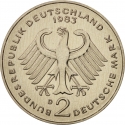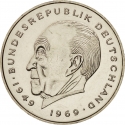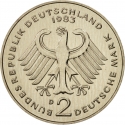You are about to finish your registration. Please check your mailbox (including spam folder). There should be a letter with a confirmation link. Check setting to make sure that your e-mail address is correct.
Send letter againDescription
West Germany is the common English name for the Federal Republic of Germany in the period between its creation on 23 May 1949 to German reunification on 3 October 1990. During this Cold War era, NATO-aligned West Germany and Warsaw Pact-aligned East Germany were divided by the Inner German border. After 1961 West Berlin was physically separated from East Berlin as well as from East Germany by the Berlin Wall. This situation ended when East Germany was dissolved and its five states joined the ten states of the Federal Republic of Germany along with the reunified city-state of Berlin. With the reunification of West and East Germany, the Federal Republic of Germany, enlarged now to sixteen states, became known simply as "Germany".
Obverse

|
The coat of arms of Germany displays a black eagle with red feet, beak and tongue on a golden field. This is the Bundesadler or "Federal Eagle", formerly the Reichsadler or "Imperial Eagle". It is a re-introduction of the coat of arms of the Weimar Republic (in use 1919–1935) adopted by the Federal Republic of Germany in 1950. The current official design is due to Tobias Schwab (1887–1967) and was introduced in 1928. BUNDESREPUBLIK DEUTSCHLAND |
|---|---|
Reverse

|
Portrait of Franz Josef Strauss. Dates 1949-1989 represent the 40th anniversary of the Federal Republic of Germany. · BUNDESREPUBLIK DEUTSCHLAND · |
| Edge |
The "Deutschlandlied" (English: "Song of Germany") has been the national anthem of Germany since 1922. Since World War II and the fall of Nazi Germany, only the third stanza has been used as the national anthem. The stanza's beginning, "Einigkeit und Recht und Freiheit" ("Unity and Justice and Freedom") is considered the unofficial national motto of Germany, and is inscribed on modern German Army belt buckles and the rims of some German coins. EINIGKEIT UND RECHT UND FREIHEIT |
2 Deutsche Mark
Anniversary of the Federal Republic of Germany
40th Anniversary of the West Germany
Subscribe series
KM# 175 Jaeger# 450 Schön# 174
Anniversary of the Federal Republic of Germany
40th Anniversary of the West Germany
Characteristics
| Type | Commemorative Issue (Circulating) |
| Material | Cupronickel |
| Weight | 7 g |
| Diameter | 26.75 mm |
| Thickness | 1.79 mm |
| Shape |
|
| Alignment | Medal |
| Mints |
Bavarian Central Mint (D) Berlin State Mint (A) Hamburg Mint (J) Karlsruhe State Mint (G) Stuttgart State Mint (F)
|
Related coins
Anniversary of the Federal Republic of Germany
Anniversary of the Federal Republic of Germany
Anniversary of the Federal Republic of Germany







